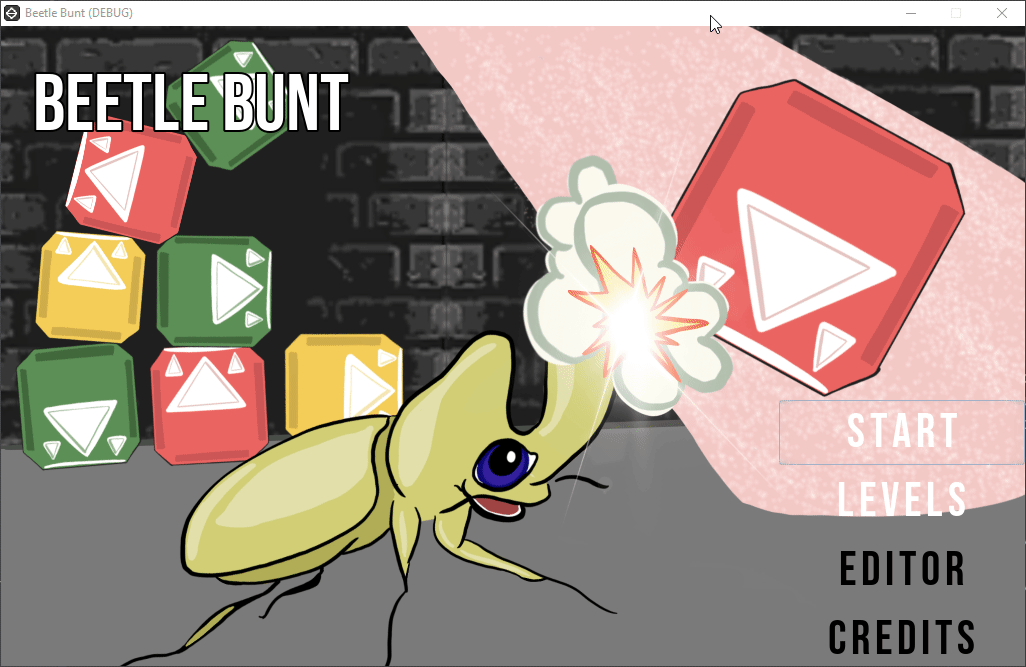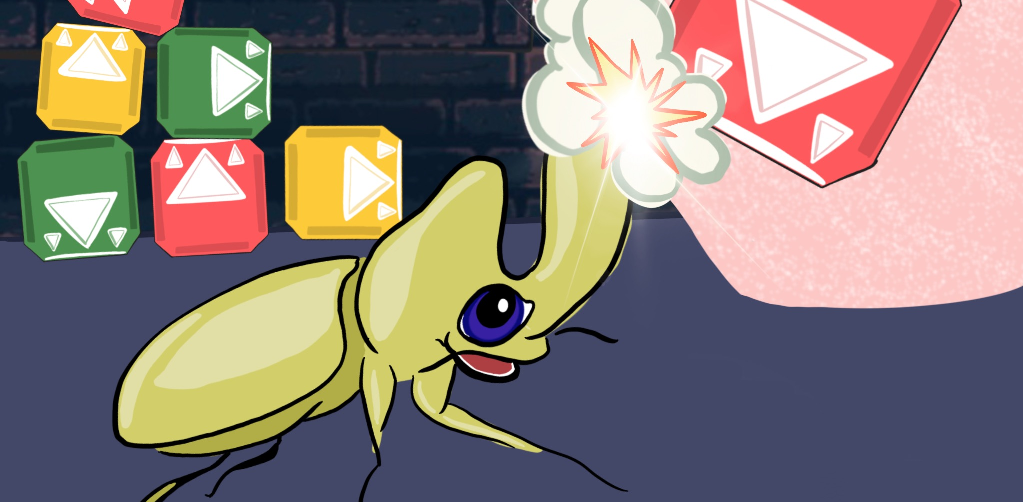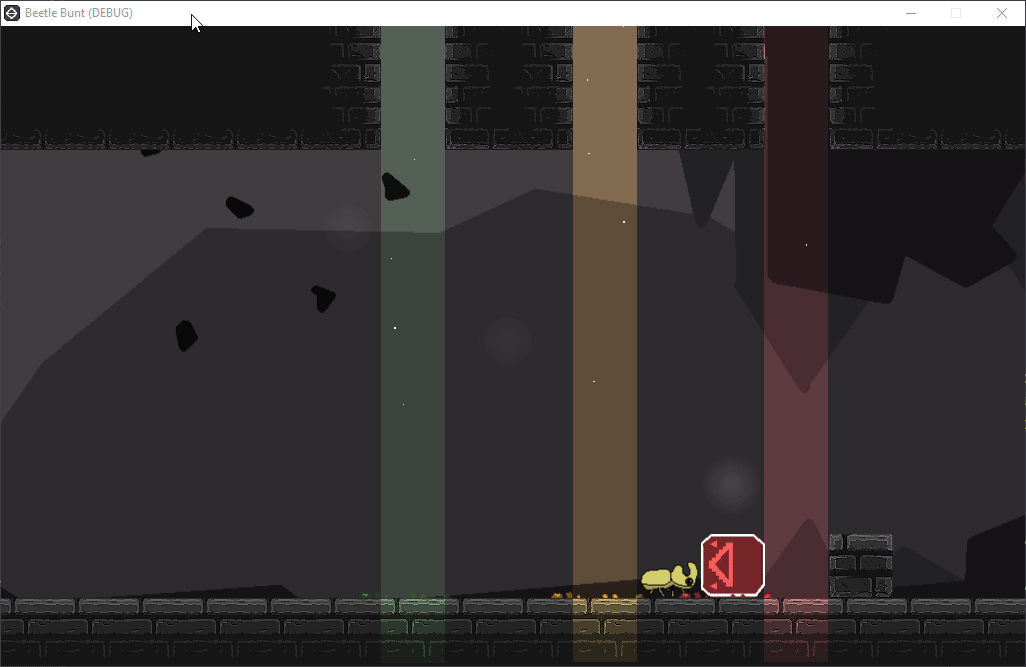Beetle Bunt: Simple ways to help the player.
Help the player learn the game in subtle ways.
In Beetle Bunt, I used very simple methods to help the player understand the game. At the same time, these methods seemed to make the player experience more enjoyable and less frustrating (my own opinion and opinions from other folks who tested the game). This devlog is a game design write-up that gives you concrete examples from Beetle Bunt that demonstrates these methods. Hopefully other designers can use these in their games.
Hint to the player when to take action.
Herc, the main beetle character in my game, likes to flip/hit things. There are many objects that need to be flipped and need to be hit at very specific points in the game. I wanted to give the player tools to do these things in a fun way.
Give the player a colored outline around certain objects.
In the early stages of my game, I saw players walking up to the tablet and spamming enter/spacebar because they didn't know exactly when the flip the tablet. Or, even worse, they'd walk up to the tablet and miss the flip - That caused some frustration when encountering levels where precision and positioning are important. And those players wanted to go through the puzzle as quickly as possible once they knew the solution. This colored outline helps the player know when the tablet can be flipped without uncertainty. It even gives the object a simple "glow" effect that encourages the player to stop and focus on the object they might be interested in flipping.

Give the player more time to make a decision.
There are later levels in Beetle Bunt that require more precision and timing when flipping/hitting objects. In combination with the colored outline hint, I allowed the player to "hold down" the flip so that they could slow down the time scale. This allows players to take extra time in order to make the right decision of when to flip.

Hint to the player what a "correct" decision looks like.
Originally, the tablets in my game had a patterned texture on their sprite to make them look like rocks. The texture was just a bunch of pebbles that looked like a rocky tile, similar to Miniboss's tiles:

Then I realized that a texture like this on a tablet doesn't make it obvious how the tablet's direction was impacted. After flipping the tablet over or 90 degrees, does the texture help the player at all? Does the player know which direction the tablet is facing? So instead of using this sprite, I used this one to emphasize the importance of the tablet's direction in my game:

Now, the player has a easier time figuring when a tablet is in "correct" position and when its not:

This might seem negligible or very specific to Beetle Bunt. But I think this is very useful when a player has to solve any puzzle involving the same mechanics in different scenarios. When the player knows what's correct, it makes it easier to draw out a solution.
But more specifically to Beetle Bunt - I created a "record" system so that players feel improvement with their puzzle solving skills. One such "record" you can set is the minimum number of flips you take to solve a puzzle. Now that it's obvious for the player to see correct positions in each tablet, they can work out an optimal solution in their head before taking any actions - Sort of like how some players can do this in chess (I can't, I suck at chess). In this example, you can say in your head "flip left, flip left, flip right" to put all three tablets in correct position with the smallest number of flips:

Let the player experiment.
This one is a more concrete example for a specific problem. In puzzle games like Beetle Bunt where there exist decision points that may prevent your progress in a particular level, getting levels/puzzles wrong can get frustrating when having to start the level all over. I've included a "save checkpoint" and "go to last checkpoint" tool to allow the player to experiment with different solutions to alleviate frustration:

Reward the player for getting better at the game.
Now that a player is better at making decisions in the game, it's only right to reward them for it! In Beetle Bunt, the game tracks how well you solved each puzzle (there are no network calls - It's all local game data on the player's machine only). That way, the game tells you how you did and if you improved since last attempt at this puzzle:

Last Thoughts
I've already written too many words. But here are some last thoughts that might also help the player in similar ways:
- Give players options to toggle the level of assistance they want in game. e.g. Give a toggle to turn off object outlines.
- Give players sound effects to associate actions with sound cues. e.g. Play a sound when a tablet is about to fall.
- Give players lots of juicy feedback so they know they can impact the game. Those actions that impact the game most: Make them the juiciest. I talked a little bit about that in my first devlog.
- When giving records to players as a reward, I felt that it was beneficial to let the player determine their own records. This encourages the player to continuously improve their own skill at the game instead of trying to reach achievement thresholds set my me.
Happy game designing,
Urodela
Get Beetle Bunt
Beetle Bunt
A puzzle game about a beetle that likes to flip things!
| Status | In development |
| Author | Dave McWave |
| Genre | Platformer, Puzzle |
| Tags | 2D, Animals, Pixel Art, Puzzle-Platformer, Singleplayer |
| Languages | English |
More posts
- Beetle Bunt 1.0 Released!Dec 25, 2020
- Beetle Bunt: Simple is fun!Dec 06, 2020



Leave a comment
Log in with itch.io to leave a comment.